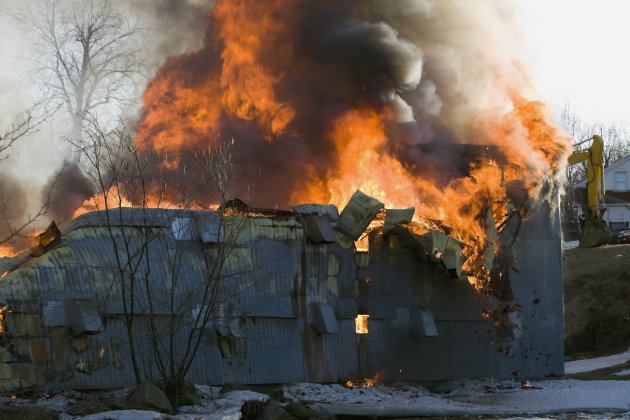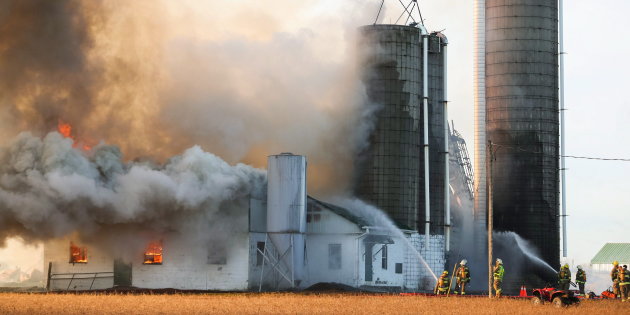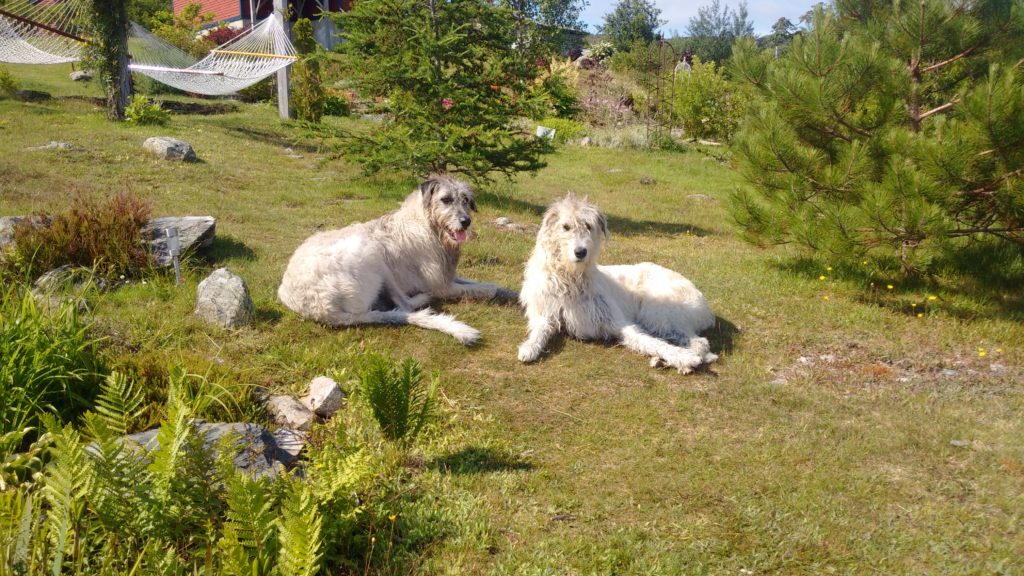Someone once said that there is nothing so appalling, so awesome as a burning barn, unless it be a burning ship at sea.

To clarify at the outset, I am not an animal advocate. I am not a card-carrying member of PETA or WWF largely because I believe in the traditional hunting rights of Newfoundlanders, Labradorians, Innu and Inuit.
Nor am I a vegan. I am a carnivorous architect.
But I am also an animal lover (especially when it comes to my dogs). To this end, I cannot bear the thought of any animal dying a tortuous death in the utter horror of smoke and fire. This post will demonstrate that such events are not only needless but preventable.
It is completely possible to design a school without sprinklers. But because the National Building Code of Canada permits it, it doesn’t make such designs worthy of praise. Having said that, the NBCC does impose all manner of fire protection measures should the consultant team decide not to sprinkler. After all, the children don’t sleep there and they have all manner of responsible adult supervision.
Buildings that house animals are similar in that you are unlikely to be required to equip them with automatic sprinklers by the authority having jurisdiction. For example, an exception may include close proximity to another building, wherein a little understood concept called “limiting distance” kicks in. I will leave that topic for another post.
Like many people, I am routinely devastated by national headlines lamenting the horrible prospect of animals burned alive in buildings that have caught fire. I recently composed a list of such headlines that went back to 2015 – accounting for the death of 470,000 animals in Canada. But to remain relatively current, I will limit my findings to a selection from this past year:
- May 21st, 2018: Sixteen Horses Killed in Barn Fire in Toronto, Ontario
- June 13th, 2018: Six Horses Killed in Barn Fire in Wellington County, north of Erin, Ontario
- July 4th, 2018: Seventy Animals Dead in SPCA Shelter, Gatineau, Quebec
This was a relatively good year. In a 25th of August 2017 article, the Huffington Post noted that in just one month in 2016, eight barn fires in Ontario killed nearly 53,000 animals. This tally included forty-two race horses, 5,000 pigs and 28,000 chickens. The Post noted:
“It is hard to fully comprehend the enormous scale of pain and desperation felt by these intelligent animals as they struggled in vain to escape the burning flames and smoke … Terrified farm animals often burn to death while those who manage to escape may suffer respiratory problems and other complications from excessive smoke inhalation.”
The Globe and Mail also noted this epic tragedy inflicted on innocent animals on the 17th of May 2017. The article’s author Jessica Scott-Reid lamented:
“While most will be disturbed to hear of the tragic death of a pet or prized racehorse, it seems few share the same sentiment for animal considered livestock, and the law reflects the same lack of concern. Farmed animals in Canada are commonly regarded as commodities, their deaths often measured by weight and financial loss rather than by number of lives. Though destined to be dinner, farmed animals are not mere products. They are sentient beings capable of experiencing fear and pain just the same as our beloved pets, and they deserve to be protected from the terrible fate of death by fire.”
Buildings that house animals are often miles away from the nearest fire hydrant. They also contain vast quantities of flammable feed (i.e. hay) and their electrical / mechanical systems are susceptible to rodent and temperature damage. But most notably, the occupants are not of the human variety, therefore they receive no protection under Canadian building codes.

The National Farm Building Code has not been reviewed or revised since 1995! That’s rather pathetic. The National Research Council indicates farm building requirements related to fire protection, structural design and dangerous goods are being discussed for publication in the 2020 editions of the NBC and NFC (National Fire Code). But don’t expect things to change all that much. Any changes will invariably be designed to protect humans – not animals.
This whole business weighed heavily on my mind back in 2004 when the City of St. John’s asked me to design an ambitious new municipal animal shelter. I could not resign myself to the fact that dogs and cats would only have human supervision for no greater than one third of any given workday. Less so on weekends. I was therefore insistent that unless an automatic sprinkler system was enshrined in the building program, they would have to find another architect. At first, this was taken to be a hard line and I got some pushback because of cost, but when the shelter staff came on board, there was no turning back. In the event of a fire, animals may get wet – a preferable outcome as opposed to the alternative.
The City is to be commended.
So animal welfare in this context is near and dear to my heart. I am also acutely cognizant of some of the hypocrisy that surrounds the issue. When researching the barn fire in 2016 that killed forty prized horses in Puslinch, Ontario, I noted that the CBC story barely generated a comment online. But when one horse was killed in the Calgary Stampede, the CBC news site garnered over two-thousand angry comments.
So in this season of good cheer, I would like to banish all the depressing sentiments I have just put before you and offer hope – or perhaps a call to awareness. The National Fire Protection Association recently published a vastly new and improved NFPA 150, the “Fire and Life Safety in Animal Housing Facilities Code”. This is an American Code. That fact should not stop its adoption in Canada. For example, in this province, NFPA 101 (Life Safety Code) is the code that governs safe building egress (for people – not animals).
This code recognizes some essential paradigms: (1) Animals are sentient beings of greater value than property (2) They lack the ability of self-preservation and (3) Current building and fire codes do not address lifesafety of animal occupants. I won’t go into the excruciating detail of this document. However, I will point out that all animal buildings are categorized, and each category asks the question as to whether or not the animals receive constant supervision or are left alone for periods of time (typically overnight). If the latter, the code generally requires such buildings (when approaching a specific size threshold in particular) to be equipped with automatic sprinklering systems.
So there is no need to agonize over this. It’s all been prepared with a huge amount of research and foresight. NFPA 150. Whether you are a farmer, own race horses, provide dog kenneling or work/volunteer with animal protection organizations, please know that this document is out there. You should reference it as your guide. At least then you will know how your plans stack up.
I would never allow my dogs to die such a cruel, agonizing and infinitely preventable death. This post is dedicated to them.


The protection of these animals by automatic sprinkler systems in case of fire is a sensible approach. These systems can save animal lives (and maybe a few human lives, too) and reduce damage and loss to property. They may also reduce the risk to firefighters called to the scene.
If the US code has adopted this standard, and Canadians use this and similar codes, then let’s have at it.